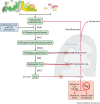TANGO2 deficiency disease is predominantly caused by a lipid imbalance
- PMID: 38836374
- PMCID: PMC11179719
- DOI: 10.1242/dmm.050662
TANGO2 deficiency disease is predominantly caused by a lipid imbalance
Abstract
TANGO2 deficiency disease (TDD) is a rare genetic disorder estimated to affect ∼8000 individuals worldwide. It causes neurodegeneration often accompanied by potentially lethal metabolic crises that are triggered by diet or illness. Recent work has demonstrated distinct lipid imbalances in multiple model systems either depleted for or devoid of the TANGO2 protein, including human cells, fruit flies and zebrafish. Importantly, vitamin B5 supplementation has been shown to rescue TANGO2 deficiency-associated defects in flies and human cells. The notion that vitamin B5 is needed for synthesis of the lipid precursor coenzyme A (CoA) corroborates the hypothesis that key aspects of TDD pathology may be caused by lipid imbalance. A natural history study of 73 individuals with TDD reported that either multivitamin or vitamin B complex supplementation prevented the metabolic crises, suggesting this as a potentially life-saving treatment. Although recently published work supports this notion, much remains unknown about TANGO2 function, the pathological mechanism of TDD and the possible downsides of sustained vitamin supplementation in children and young adults. In this Perspective, we discuss these recent findings and highlight areas for immediate scientific attention.
Keywords: Lipid imbalance; Metabolic crises; Neurodevelopmental disease; TANGO2 deficiency disease.
© 2024. Published by The Company of Biologists Ltd.
Conflict of interest statement
Competing interests The authors declare no competing or financial interests.
Figures



References
-
- Berat, C. M., Montealegre, S., Wiedemann, A., Nuzum, M. L. C., Blondel, A., Debruge, H., Cano, A., Chabrol, B., Hoebeke, C., Polak, M.et al. (2021). Clinical and biological characterization of 20 patients with TANGO2 deficiency indicates novel triggers of metabolic crises and no primary energetic defect. J. Inherit. Metab. Dis. 44, 415-425. 10.1002/jimd.12314 - DOI - PubMed
Publication types
MeSH terms
Substances
Grants and funding
LinkOut - more resources
Full Text Sources
Molecular Biology Databases

